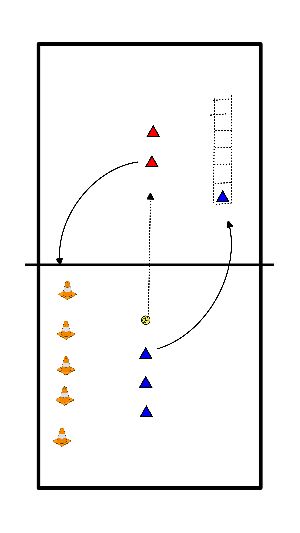Volleyball drills for technique passing / defense / reception
Pass and overarm exercise
- Player A and A1 have the ball.
- This player throws the ball to player B/B1
- Player B/B1 passes the ball back 'perfectly'
- Player A/A1 then plays the ball in the basket.
- Player A/A1 picks up the ball and joins the back of the line. You follow your ball
The tempo is automatic and can be increased. Make it harder by letting player B pass elsewhere, so player A has aim for the basket. Other option: Player A throws to a more difficult spot in the field.
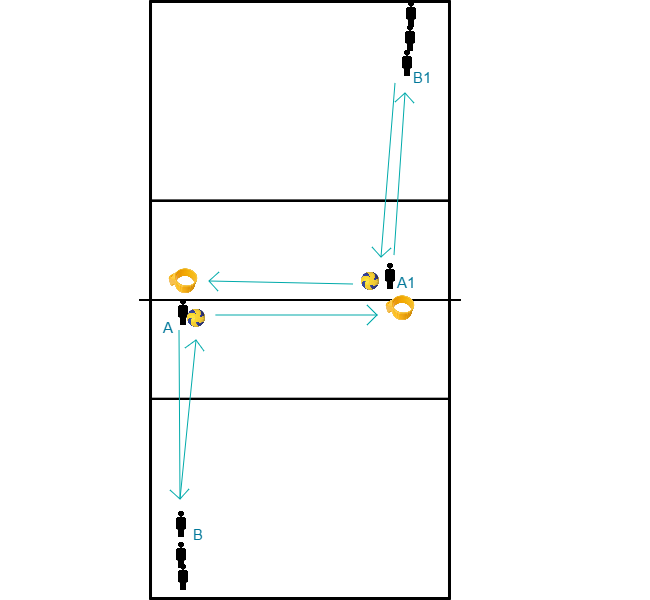

| If you put pressure on the opponent with your service and attack, the balls easily get over the net. It is a must to process these balls properly and (quickly) set up another attack. Precision is of the highest importance. The responsibilities have to be clear and taken by the players. It has to be clear for whom the easy ball is and who passes it. The place to which the ball is passed must also be clear. The speed of the rally pass is also of importance. Particularly when the playmaker is forward, you can pass the ball quicker to the net. Closer to the net, you pass the ball a bit higher, so everybody has time to prepare for the attack. The exercise: Coach throws ball in to the six. They build up an attack The six have to score from the rally pass. The four have to prevent this by blocking the ball and defend. When the 6 have 5 points, change. score keeping:
|
Estimate ball trajectory, shuffle, stand still, shoulders correctly, and pass properly.
- 3 players are at the net/ 3 meter line.
- 1 catcher
- Trainer hits the ball
- players shuffle backwards and pass to 2/3 players
- catcher catches and puts ball in box.
- passer to catcher
- empty space is filled
- 2 pairs 1 ball
- the one pitches NEXT to the body
- the other passes
- Pay attention that the one shoulder goes down and the other shoulder goes up
- Do make a plank
- The most service passes are pitched next to the body
- pairs with 1 ball.
- Pass with 1 arm and every time a bounce in between.
- Alternate left and right.
- Pay attention that they correctly turn their body, as in tennis.
- Player stands with bucket above head at the net
- You can move a little, but not bend over!
- Player with bucket remains for 1 round
- Trainer is on the end line/or in the middle of the field with 2 lines players:
- 3 players with ball (with trainer)
- 3 without ball (on the end line)
- Player with ball pushes ball in hands trainer
- Trainer randomly throws ball in field and player dunks ball in bucket
- in the bucket is a point
- player takes his own ball and joins line with ball
- walk back around
- in the bucket is a point
- Make increasingly difficult!
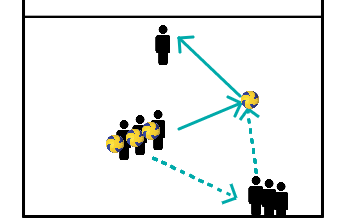
- 2 lines of players
- 1 line left in the back
- 1 line right in the back
- create a virtual line with 4 cones behind which they have to line up
- trainer is on the other side of the net and throws the ball somewhere in the field
- 1 of 2 most front in the line callsLET GO or IK (agree)
- this player passes the ball over the net to the previous player
- a round of catching for the next
- If you did not have the ball, join the shortest line
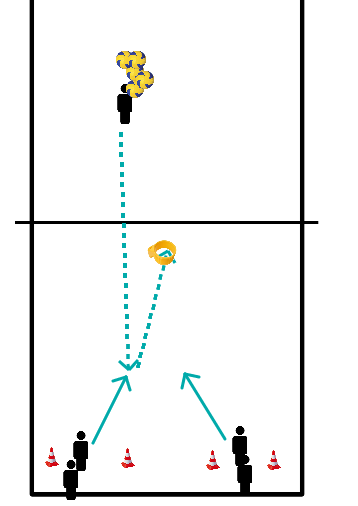
pay attention in the exercises:
- Pass has to be high, so the player can catch 'overarm'.
- Pass to right, right foot front
- Pass to left, left foot front
- 'Eyes' of the shoulder in playing direction
The exercise:
- trios with 1 ball
- 1 and 2 are next to each other, not too close to the net.
- 3 is opposite 1 in the back of the field.
- 1 throws straight to 3, and 3 throws diagonally to 2
- 2 catches and then throws straight to 3 and 3 throws diagonally to 1.
- so 3 keeps moving
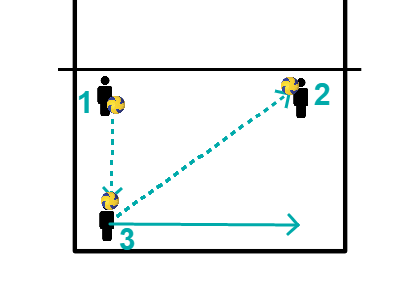
pairs with net in between.
- Throw ball with stretched arms and 1 foot before the other over the net.
- Trainer throws ball over the net
- Player tries to catch and throws the ball with
- stretched arms
- and 1 foot before the net
- and touches the chest.
- Hit chest, you take a peg and attach it to your shirt
- How many pegs do you have at the end?
Idem, only knock the ball overarm
- Move the chest once in a while
- trios with 1 ball.
- A and B are at the net, and C is opposite of A on the end line.
- A throws ball to C, C throws diagonally to B, B catches.
- Meanwhile, A moves with regard to B, and then A throws the ball to C.
- After 20 passes rotate
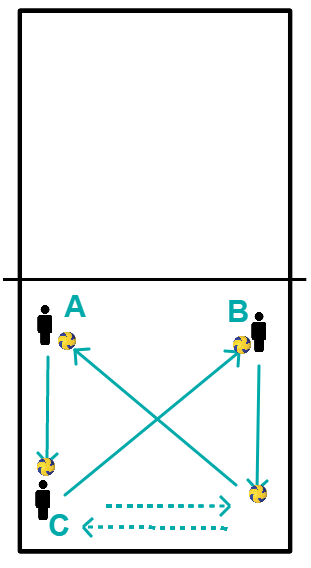
- Split the group into pairs.
- The pairs will work through a number of stations, where different tasks have to be performed.
- Station 1: A slalom through several poles, with an underhand pass at the end of the slalom.
- Move as fast as possible between the poles.
- Station 2: One player lies down on the backline, while the other stands at the net with the ball.
- Player at the net hits the ball.
- Player in the backfield then stands up, and defends a hit ball at 7 meters, or a prik ball at the 3 meter.
- Station 3: Player stands in front of a trampoline, behind player 1 stands a second player with 2 tennis balls.
- One tennis ball is thrown into the trampoline, player 1 catches it before it hits the ground.
- The second tennisball is thrown quickly after it.
- Station 4: Simple, good block jumps, paying attention to the technique.
- Station 5: Reflex training: player stands with arms outstretched, a ball in each hand.
- Player 2 faces the other player, and reacts to the release of one of the balls.
- Do not make the distance between players too great to begin with.
- Each station has a working time of 1 minute.
- Divide the team into two groups and have them form two rows facing each other on the 3-meter line.
- Have the players play over the net and then walk around the cone to join the other group.
- On 1 side, parallel to the sideline, place a speed ladder and before joining the line, have the players do a drill through the ladder.
- On the other side, place pawns where they have to slalom, turn around.
- Importantly, the ball should not fall to the ground, communication is important.
- Optionally add a penalty if the ball falls to the ground. Head roll, Back roll.
- First with underhand throwing and catching - then overhand. Catch and push change to toss up and over-key.
